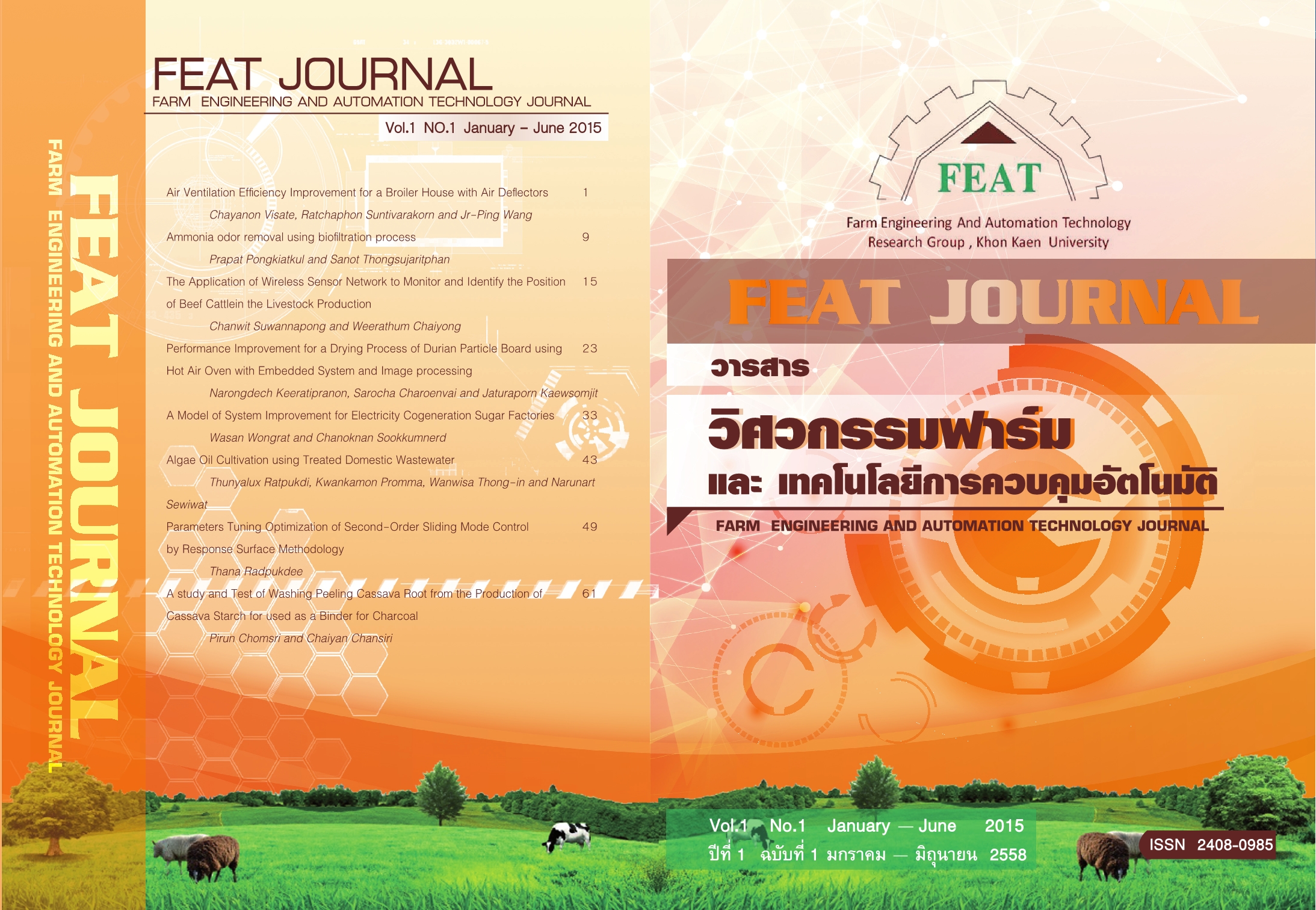Ammonia odor removal using biofiltration process
Main Article Content
Abstract
This study focuses on determination of maximum loading in a continuous biofilter system to eliminate ammonia gas under a steady state. Contaminated air with ammonia gas was injected into the system, containing Nitrifying Bacteria attached on 1.5-L ceramic rings as a medium(surface area=1.2 m2/g and total pore volume = 0.0029 mL/g). The experiment was conducted at inlet ammonia concentrations of 50 ppm, 100 ppm, 200 ppm, 300 ppm, 400 ppm and 500 ppm. The results show that the average efficiency of the system at 50-ppm inlet concentration was 83.1%. The overall efficiency remained high even the inlet concentrations were increased to 100 ppm 200 ppm 300 ppm and 400 ppm (efficiency = 90.4%, 85.8%, 66.3% and 49.8% respectively). Highest mass loading rate of 16.7 g NH3/m3×h (inlet concentration = 400 ppm) was determined and maximum elimination capacity was found as of 8.3 g NH3/m3×h. However, the removal efficiency was reduced to 31.1 % after the inlet concentration was reached at 500 ppm. This is because the condition enhanced a growth rate of Nitrosomonas Bacteria in the system to be higher than the rate of Nitrobacter Bacteria. Accumulation of nitrite in a system inhibited growth of Nitrobacter Bacteria and finally resulted to efficiency reduction.
Article Details
วารสารวิศวกรรมฟาร์มและเทคโนโลยีควบคุมอัตโนมัติ (FEAT Journal) มีกําหนดออกเป็นราย 6 เดือน คือ มกราคม - มิถุนายน และกรกฎาคม - ธันวาคม ของทุกปี จัดพิมพ์โดยกลุ่มวิจัยวิศวกรรมฟาร์มและเทคโนโลยีควบคุมอัตโนมัติ คณะวิศวกรรมศาสตร์มหาวิทยาลัยขอนแก่น เพื่อเป็นการส่งเสริมและเผยแพร่ความรู้ ผลงานทางวิชาการ งานวิจัยทางด้านวิศวกรรมศาสตร์และเทคโนโลยีพร้อมทั้งยังจัดส่ง เผยแพร่ตามสถาบันการศึกษาต่างๆ ในประเทศด้วย บทความที่ตีพิมพ์ลงในวารสาร FEAT ทุกบทความนั้นจะต้องผ่านความเห็นชอบจากผู้ทรงคุณวุฒิในสาขาที่เกี่ยวข้องและสงวนสิทธิ์ ตาม พ.ร.บ. ลิขสิทธิ์ พ.ศ. 2535
References
toxprofiles/tp126.pdf.
[2]NIOSH (1992). Recommendations for occupational safety and health: compendium of policy documents and statements, Cincinnati, OH: U.S. Department of Health and Human Services, Public Health Service, Centers for Disease Control, National Institute for Occupational Safety and Health, DHHD (NIOSH) Publication No. 92-100.
[3] Wark, K., Warner, C.F., and Davis, W.T., 1998. Air Pollution Its Origin and Control. Addison Wesley Longman Inc, Third edition, ISBN 0-673-99416-3.
[4] Baquerizo, G., Maestre, J., Machado, C.V., Gamisans, X., Gabriel, D., (2009). Long-term Ammonia Removal In Coconut Fiber-packed Biofilter: Analysis of N Fractionation and Reactor Performance Under Steady-state And Transient Conditions, Water Research Journal, vol. 43, pp. 2293-2301.
[5] Taghipour, H., Shahmansoury, M.R., Bina, B. Movahdian, H., (2008). Operational Parameters in Biofiltration of Ammonia-Contaminated Air Stream Using Compost-Pieces of Hard Plastics Filter Media, Chemical Engineering Journal, vol. 137, No.2, pp.198-124.
[6] Jun, Y., Wenfeng, X., (2009). Ammonia Biofiltration and Community Analysis of Ammonia-Oxidizing
Bacteria in Biofilters, Bioresearch Technology, vol. 100, pp.3869-3876.
[7] Maia, G., Dayv, G., Gates, R., Taraba, J., (2012). Ammonia Biofiltrattion and Nitrous Oxide Generation during The Start-up of Gas Phase Compost Biofilters, Atmospheric Environmental, vol. 46, pp.659-664.
[8] Nicolai, R., (2005). Biofilters, Livestock Development in South Dakota Environment and Health, vol. 1, pp.1-8.
[9] Sun, Y., Quan, X., Chen, J., Yang, F., Xue, D., Liu, Y., Yang, Z., (2002). Toluene vapour degradation and microbial community in biofilter at various moisture content, Process Biochemistry, vol. 38, pp.109-113.
[10] เสาวลักษณ์ ภู่นภาอมร และ วงศ์พันธ์ ลิมปเสนีย์, (2553). Efficiency of Ammonia Removal by Biofilter, วารสารสิ่งแวดล้อมไทย, ฉบับที่ 24, ครั้งที่ 2, หน้า 127-135.
[11] ธงชัย พรรณสวัสดิ์ (2551) การกำจัดไนโตรเจนและฟอสฟอรัสทางชีวภาพ, พิมพ์ครั้งที่ 3, วิศวกรรมสถานแห่งประเทศไทย ในพระบรมราชูปถัมภ์, หน้า 56-102.
[12] Kim, J.H., Rene, E.R., Park, H.S., (2007). Performance of an immobilized cell biofilter for ammonia removal from contaminated air stream, Chemosphere, vol. 68, pp.274–280.
[13] Ruiz, G., Jeison, D and Chamy, R., (2003). Nitrification with High Nitrite Accumulation for The Treatment of Wastewater with High Ammonia Concentration, Water Research, vol. 37, pp.1371-1377.
[14] Grunditz, C., Dalhammar, G., (2001). Development of Nitrification Inhibition Assays Using Pure Cultures of Nitrosomonas and Nitrobacter, Elsevier Science Ltd, Vol. 35, No.2, pp.433-440.

